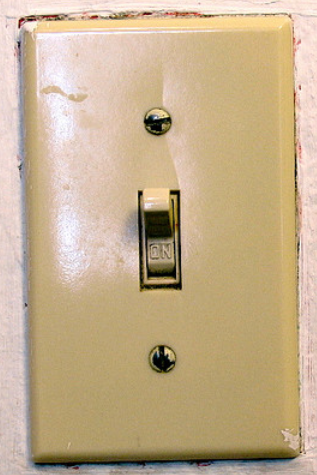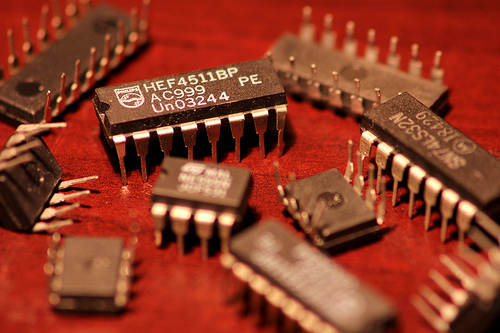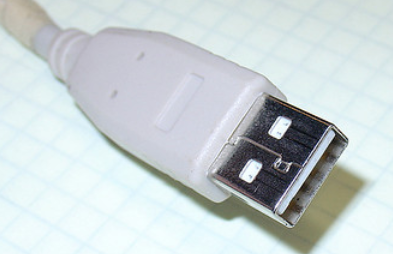Introduction to Computers with Ubuntu Unity
Desktop Hardware Basics
Experts and media gurus describe desktop computers as being on the way out. OK, maybe laptops are taking their place in many offices and homes in the 20-teens (it is 2013 at this writing). Even more portable tools like tablets, smartphones, even flexible/wearable computers are on their way to device dominance. Even the experts don't predict accurately beyond a few years.
Desktop hardware may be of marginal interest to many, but the fundamental physical components of a computer remain. It is worth understanding them as they exist in a desktop computer because the components are found in all versions of computers, even though they are smaller, more integrated, faster...and faster...and faster.
Hardware is the physical parts of any computer, no matter the size.
At its most basic, all the hardware parts are organized around switches.
|

Photo Credit: madabandon on Flickr [cc-by-nc-sa]
|
This is the kind of switch most of us in the US will recognize right away. Behind the wall plate, a wire connects to one side of the switch mechanism. Another wire connects on the other side. When the switch looks like this one, (ON), electricity goes through and somewhere nearby a light shines. When a person reaches out and flicks the switch OFF, the mechanism inside opens a gap so the electricity cannot go through. The light goes off. In the depths of night, it gets very dark. Now you need to exercise your imagination. The switches inside a computer are smaller. They are tiny. They are almost too small to see, even with a good microscope. |
The tiny switches are electronic. That means you don't reach inside the computer to poke a teeny lever to turn them on or off. Modern computers depend on the transistor, the same kind of switch that made lightweight, battery-powered radios possible.
Since the days of the transistor radio, engineers have found even more exotic ways to make wires and electronic switches smaller. In the middle of the 20th century, the earliest electronic-switch computers took up rooms the size of a typical school classroom. The same computer capability these days can be found in a part called an integrated circuit the size of a pinkie finger's fingernail.

Image Credit: Dave Lanovaz on Flickr cc-by-nc-sa
These pictured integrated circuits, which are also called "chips" are actually bigger than the ones inside your desktop, laptop or wireless phone. I mention wireless phones because they are the current state-of-the-art for consumer computers. Smartphones are more powerful than the mainframe computers of the 1950s. All the components of a desktop are there inside the cellphone which slips easily into a shirt pocket.
Computer Components
Monitor
The screen of a computer is probably the most visible part of your computer. It sits on your desktop and displays the windows of your Graphical User Interface (GUI). The monitor/screen is an "output" device. Information is visible because thousands of electronic switches determine the location and color of tiny dots of the screen. Each dot is so small that you don't notice it individually unless you look very closely at the screen. Each of the dots is called a pixel which is short for "picture element." The laptop on my desk has a screen which displays 1366 pixels across the width of the screen and 768 from top to bottom. Each pixel has a set of switches which control the amount of red, green and blue and brightness. If it were four switches for each pixel, that would mean
4 times 768 times 1366 = 4,196,352 switches going on-and-off, on-and-off, on-and-off. The same thing is happening inside the modern LCD and LED flatscreen televisions. For those, the cable set-top box is the controller. Your own monitor may have a different arrangement of pixels. The "resoluton" of the screen determines how many pixels are involved. People watching movies and playing high speed games want the highest quality resolution.
Central Processing Unit (CPU)
For your computer, the controller is called the Central Processing Unit. The CPU is an electronic control box that handles the instructions of the programming software. The software is written by human beings. It says what a window looks like when you see it on the screen, It determines how the pixels of color will be arranged on the screen. As you read these words, you are looking at the dots/pixels and probably are seeing black letters on a white background. That's the standard set of colors used in Web browsers to display text. Thousands of pixels are involved.
The CPU gets instructions from the controlling software program. It gets the switch codes for each letter of each word in each sentence...You get the idea. The result is that the screen output reflects the input of software instructions. The message you are seeing in your browser window on the monitor screen is the one I instructed it to show. You are not seeing random dots of color. The dots are controlled carefully by the instructions received by the CPU and processed out to the screen as exactly arranged dots of color.
Current CPUs have an edge over older ones. Highly integrated chips make it possible to create multiple "cores" inside the same CPU chip. A core is basically a CPU unit. With several cores, it is like having many CPUs. "Dual Core" CPUs are common these days. "Quad Core" (4 core) CPUs are available. Even smartphones have multi-core processors (for a premium price). Multi-core CPUs can efficiently multi-task, each core can be used to deal with a separate job. Running several programs at once becomes a reasonable thing to do.
The CPU is very busy at the center of the computer, but it has connections to many other physical parts.
Graphic Processing Unit (GPU)
Fancy pictures sent to the appropriate pixels on the monitor can take a huge toll on the CPU (remember all those switches) and do so on the less expensive computers. The least expensive computers are not suitable for big monitors and watching action movies delivered through the Internet with video streaming services like Netflix, iTunes, etc. To improve the speed of graphics, one can add a processor dedicated to contolling the pixels heading to the screen. In those systems, the CPU sends all the graphics processing commands to be handled by the GPU. The result is better, flicker-free movies and games.
Remember that hardware is in contrast to software. Software is the set of instructions which control which switches go on or off and the timing of those switch flips.
Random Access Memory (RAM)
Software and movies and even the text of this user guide need to be stored. Short-term "live" storage is important because efficient display requires quick access. Live storage is accomplished with switches (like everything else in computer hardware). The faster we can turn the switches on and off, the faster the pictures can change. The CPU runs fastest, most efficiently, when it can grab a sequence of pixels from fast storage. RAM is very efficient for short term storage of pictures, movie frames, game screens, even long, boring text pages.
The more RAM your computer has, the more work you can do simultaneously. Now, if you are watching a movie on your computer, you are probably focused on that until the movie ends. But, if you are working at your office desk, you might be running several programs at the same time. You might have your word processor program running to do the monthly company newsletter. Along with that, you have your email program running because you are waiting for the last article. You also have your Web browser running to get useful pictures for the newsletter (preferably liberally licensed ones like the ones in this guide) from the Web.
No matter how efficient your CPU is, it needs RAM to store the documents, Web pages, and email attachments you are actively using. If you don't have enough RAM, the CPU will need to swap the data and programs from and to longer-term storage. RAM is quick and efficient storage. Swap storage takes longer to access than RAM. Your multi-tasking slows down. You get frustrated when you have to wait when switching from the word processor window to the browser window to the email window and then back.
Hard Disk Drive
Swap storage is done on a special section of space on a hard disk drive. While RAM switches are volatile, all of them switching off when the electricity goes off, disk drives provide a stable long term storage solution. Instead of electronic switches, disk drives use magnetic storage. Each individual switch of a picture gets recorded as a very tiny magnet pointing north (up) on the surface of a spinning disk. The switches that should be off are recorded as a magnet pointing south (down) on the spinning disk. Modern disk drives store the state of billions of switches. Disk drives are called "hard" because the magnets are arranged in circles on metal disks. The disks spin rapidly and an electromagnet floating just slightly above the surface reads or writes switch data (a zero represented by a "down" magnet - on represented by an "up" magnet).
Swap storage is done on the hard drive, too. Even though the disk may be spinning at 5200 revolutions per minute, it takes much longer to read the data from swap storage than from RAM.
Once the data is written to the disk drive, it can also be left there for later. Magnetic disk data storage is stable for years. It isn't like RAM, remember, which uses electronic switches to represent data. The electronic switches all go off when you turn off the computer. No power, no data. All RAM switches go off when you power down the computer.
By contrast, it takes an intent to make a change of magnetic data on a hard drive. Turning off the computer doesn't turn "off" all the magnets. That's great for long-term storage.
CAUTION:
When you get rid of your computer, all the data that was stored on the disk drive (hard drive) is still there. If you have sensitive, private data, no matter what the format, take time to erase your disk before you recycle it. GNU/Linux has several utilities that are great for this job.
CPU, RAM, Hard Drive, Power Supply, Cooling Fan and all their connecting wires are contained in a box. That box is sometimes made of metal and can sit next to your desk. It is then typically called a "tower." Actually, some people just call it the CPU. They are being lazy, but the box does contain the CPU, so maybe it is okay.
The same box of parts is beneath the keyboard in a laptop computer (all the parts are much smaller).
Wires run out from the back of the tower to the external parts of your system. Those wires carry the electronic signals to all the peripheral parts of the system. We started this hardware discussion with the monitor. It connects to the tower with a special, thick cable. The other peripherals generally connect with a standard cable type, the Universal Serial Bus (USB) cable. Not so long ago, most peripherals had their own design of connecting cable. USB has made things much simpler.

USB Connector - Image Credit: Jeff Keyzer
Keyboard
When we write a newsletter or any other document, the keyboard peripheral makes it relatively easy. Of course, to be efficient, you probably should learn to touch type. The programmers who make the software to control your computer spend hours and hours at the keyboard. Most programmers find the keyboard the most efficient way to enter all the codes that run your computer.
Mouse
Today's typical computers are universally dependent on a Graphical User Interface (GUI). You need a peripheral that moves the pointer around the screen. The mouse is the input tool of choice. If you own a smartphone or tablet, the monitor screen is touch sensitive, and your finger tip takes the place of the mouse for moving the pointer and doing mouse-button clicks, too.
Printer
While a lot of reading we do is on the screen in a browser window, there are times that a paper copy is preferable. You can connect a printer to your computer using a USB cable. GNU/Linux will recognize most printers and let you start printing right away.
There are a few classes of printer from which you can choose these days.
- Inkjet - sprays dots onto the paper - expensive ink
- Laser - dusts and melts the ink onto the paper - moderate price
- Multifunction - may be either inkjet or laser - often has printer, copier, scanner and fax functions.
- Network - may be either inkjet or laser - shared among several computers in the same office. Reduces cost, fewer printers in the office. Often doubles as a copier.
© 2013 Algot Runeman - Shared using the Creative Commons Attribution license.
Source to cite: - filedate:


